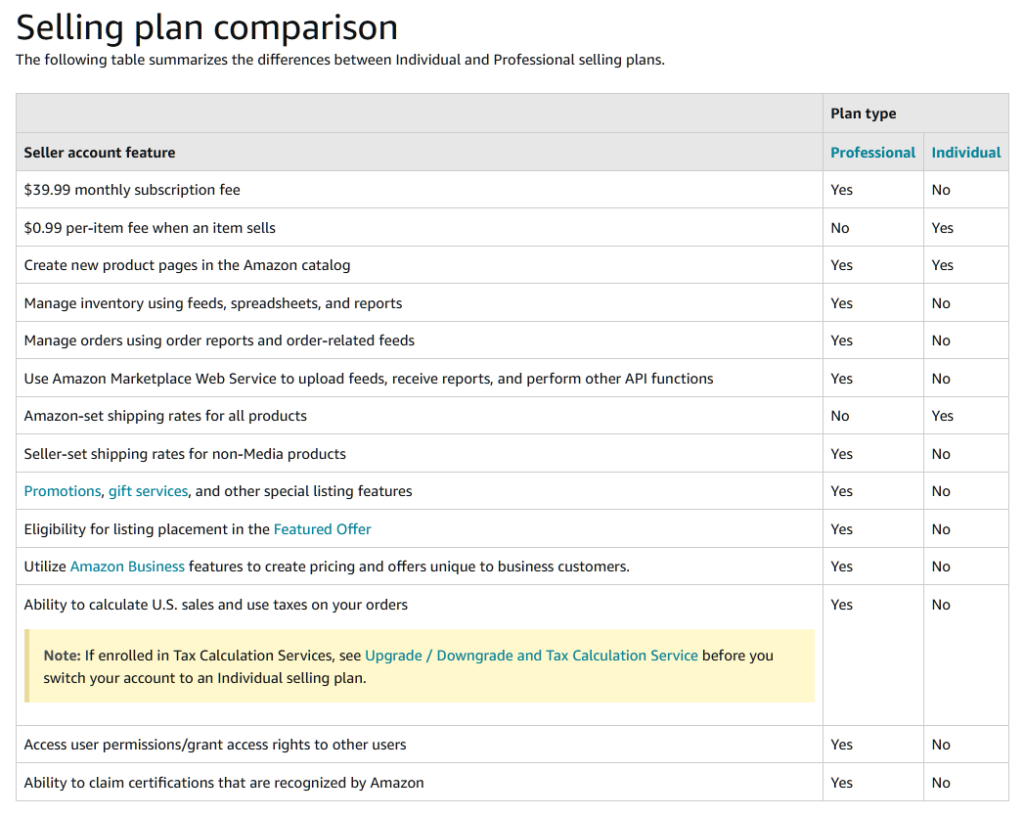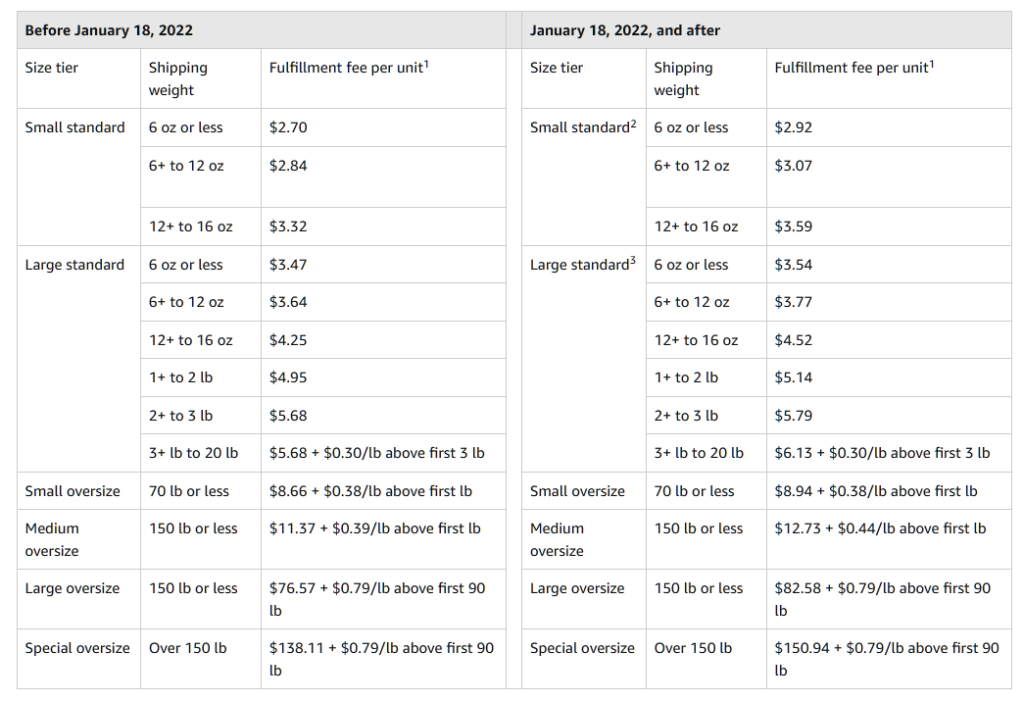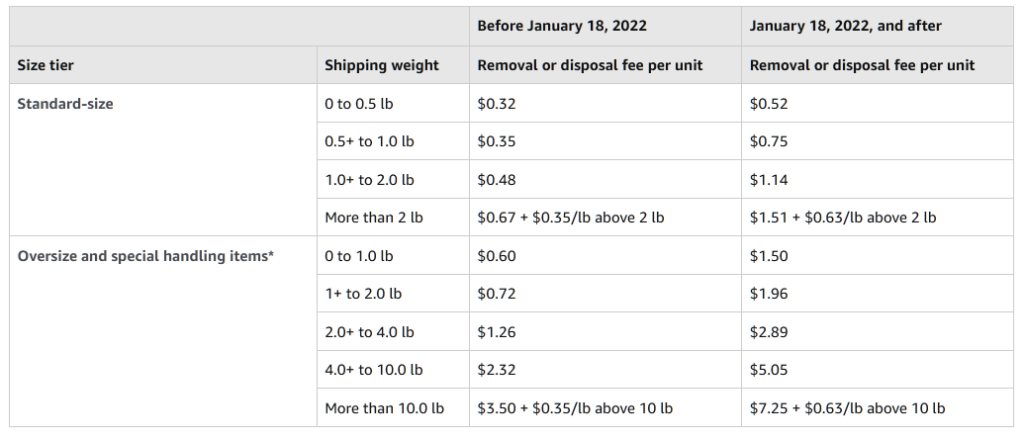With the new year, there are new opportunities to grow. And new changes to worry about. On January 18, 2022 Amazon will be rolling out new changes to many of their fees which will affect you in the coming year.
Is this good news or bad news?
Here’s what’s happening and how you can stay ahead of the curve to grow your Amazon business even faster in 2022.
Table of Contents
But first, let’s quickly look at the kind of costs and fees you might face as a seller on Amazon, and then how you can turn them in your favor.
1. The Basic Stuff: Account and Sales Fees
This is probably something you’ve already sorted out when you first set up your business, but let’s not gloss over it.
As an Amazon seller, you’ve got two plans available to you: Individual and Professional.
Naturally, the Individual plan is more suited to small sellers with low volume, with a $0.99 fee on each item sold. Professional is more suited to businesses selling serious amounts of product, with no per-item fee, but a $39.99 monthly subscription fee. You should know immediately what works best for you.
Below you can see Amazon’s own comparison of the two plans:

Other sales fees, such as Referral fees may vary based on the type of product, but are the same for both account plans. The only difference of note for 2022 is a reduction in Referral fees for lawn mowers and snow throwers from 15% to 8% for products with a total sales price greater than $500.
The choice is simple, and there’s nothing you can do beyond it, so let’s move on.
2. The Black Hole: Fulfillment Costs
This is the bulk of your costs as an eCommerce retailer, where your tight profit margins go to shrivel up and die. Whether you’re fulfilling yourself or using OF or FBA, a huge chunk of your revenue will be spent on fulfillment costs.
These costs may include services such as:
• Storage;
• Insurance;
• Staffing;
• Packing;
• Labeling;
• Processing;
• and, of course, Shipping your products to their worthy destination.
Outsourced or Self-Fulfillment may be a good choice for your business, but in this article we will be looking at Fulfillment by Amazon in particular, the new fees from January 18th, and what you can do to manage them…
In just a moment.
3. The Grease: Marketing Investments
While getting your products hosted on Amazon’s platform and making sure they’re effectively delivered is necessary to operate and grow your FBA business… So is getting your products in front of your audience and convincing them to buy.
Marketing and advertising are a crucial element in any successful eCommerce business, serving as the grease anointing the cogs in your vehicle. And if you want things to run smoothly and increase your overall profits, you better have a good grasp of your marketing expenses. Make sure you’re measuring results and getting good returns on your investment.
The types of marketing costs you might face include:
• Cost-per-Click Advertising for your products, on Amazon or externally;
• Product listing optimization and copywriting;
• Discounts and promotional campaigns;
• Improved customer service;
• And all sorts of other things that make people buy more of your product.
Whether you’re competing for the Amazon Buy Box, or you’re trying to get your products to the front page, or simply want to maximize positive reviews and word-of-mouth marketing… There are many ways in which you can optimize these costs and ensure they’re profitable investments.
You may do some things yourself, or hire an expert to do them for you, but sadly this section is out of the article’s scope and will have to be explored another time.
If you are interested in learning how you can best grease your eCommerce machine and get the most out of your marketing budget…
The best way to get on the right track is to reach out and get in touch. We’ve got the guidance and solutions you need to start growing in the right direction, and the contacts you can use to ensure healthy growth.
Just let us know what you need to solve in your business.
And now, to the most useful part…
How Do You Escape The Black Hole?
When you’re stuck behind the event horizon, slowly drifting away towards your inevitable spaghettification, it’s difficult to notice what’s going on. The signs are there: low profit margins, stagnation, products being outcompeted, and the constant need to put work into your business to keep things running.
And it would be nice if I could say that there is an easy fix, but it’s a black hole for a reason. It’s hard to escape. It takes energy, and time, and the right tactics.
Assuming you have the former two, let me discuss a few tactics you can employ within your escape strategy to turn your vehicle around and make it back into the vast space of eCommerce opportunity. Safe and sound.
Here are Amazon’s new FBA fulfillment fees, starting from January 18th 2022:

As you can see, there is a marginal, but significant increase in the costs per unit, ranging from 2% to over 9%.
You can find more details on Seller Central here
This was important before, but it’s even more important after these changes. And it might seem obvious, but few sellers actually take the time to worry about these aspects and cut down their costs. Parcel size and weight!
Which brings me to…
Tactic #1: Parcel Perfection
It’s pretty simple. You could pack things better, cut down on excess weight, and generally be slick about how you showcase your product. Your customers will thank you. Amazon will like you. And you’ll be rewarded with lower fees, better reviews, and higher profit margins down the line.
The first thing to do is to ensure that the dimensions you currently have are accurate. Amazon’s workers are exhausted and under pressure to move quickly, rather than accurately, and despite using cutting edge algorithms and high-tech warehouse robots… Most work is still done by humans! And humans make mistakes.
If your products are registered as a higher size or weight than they’re supposed to be, you may be charged a higher fee than you’re supposed to. It’s pretty common.
So keeping track of your product sizes and weights and keeping Amazon accountable when they overcharge you is pretty important.
You can run a Fee Preview Report and estimate your FBA fees, then compare with your own inventory data. Amazon sometimes updates your product dimensions without telling you and errors show up, so constant vigilance is required. When you identify these issues, you can request a re-scan on the products in question and, hopefully, get accurate dimensions and your fees reimbursed.
If you’re not sure how to do all this, or you’d like to off-source this kind of work to an expert, click the button below and we can perform a free audit on your inventory, for this issue, as well as all important sources of lost revenue.
Once you’re sure your inventory is correctly measured, you can go ahead and work on cutting down excess size and weight on future deliveries. The best place to start is borderline products, which lie on the edge of the various size and weight tiers you can review above.
For example, in the Large Standard tier, the fee for units between 1 and 2 lbs is, starting from the 18th of January, $5.14, while those between 2 and 3 lbs are charged $5.79. That’s a $0.65 difference, whether your unit weighs 2.1 lbs or 2.9 lbs. If you can lower the weight of your units in the example above, from 2.1 lbs to 1.9 lbs, the difference simply gets added to your profit margin. And if you sell 1000 such products per month, that’s $650 saved every single month. It can really add up.
Ways to do this can be:
• Using a thinner and lighter padding material;
• Packing auxiliary objects inside the main product;
• Eliminating empty space through disassembly and better stacking;
• Or employing a bit of creativity…
Carefully look at the fees and tiers and identify the units in your inventory that just barely exceed one of the tiers or subtiers. And if you lower a product’s dimensions enough, maybe it can qualify for the FBA Small and Light program. It comes with free shipping for Prime customers and reduced shipping fees in general.
(Those fees are changing as well.)
Can you bring them beyond the threshold? That’s one way to escape the Black Hole.
Those further away from the edge will have a more difficult time crossing over, so may require a bit of a rework. What you can do more easily, however, is bundle products of different sizes together so that the collective average goes down.
Anyway, moving on…
Tactic #2: Selective Storage
Space is valuable, so of course Amazon is going to charge you to store your stuff. Starting from February 1st 2022, storage fees will, unsurprisingly, go up yet again. And, as you’re probably aware, the longer they store your stuff, the more they charge you.
Storage fees include:
• January to September storage fees;
• October to December storage fees;
• and the so-called “aged inventory surcharge.”
You can find a more detailed overview here.
Why do they charge different fees at different times of the year? Beats me. But this is why it’s important to make sure Amazon is only storing as much inventory as is being sold, and you don’t overdeliver. You should keep a buffer, to avoid running out of stock unexpectedly, but try to keep a balanced stock.
Now, what you might miss is that sometimes inventory can be marked as “undeliverable” or “stranded” by Amazon, whether due to an unexpected issue, or even by mistake, which makes your product stuck in storage. Possibly forever. All while still racking up storage fees.
You may run an Inventory Health Report and check the status of your products. If you’ve used it before, things are changing in this area as well. More information here.
In the event that a product is, in fact, undeliverable, you may use the FBA Liquidations system, try to resell it as used, or, in the worst case, dispose of it to avoid the accruing storage fees.
But, Amazon won’t even take out the trash for free. When liquidating or disposing of your products, Amazon will charge you another set of fees, which also change in January, as you can see below.

More info on removal and disposal fees here.
Then, do the math on the inventory you’re sending to Amazon. Large parcels take more space, while heavy items are charged extra. You may have optimized the sizes and weights for delivery’s sake, but some items might be better off being stored outside Amazon’s fulfillment centers, and only delivered when the stock is running out.
But there may still be things you’re missing…
Tactic #3: Pre-Prepare Prep
Amazon is a really efficient business. There’s a reason they have one of the biggest valuations on the planet. Part of that is charging for absolutely everything, as you’ve probably already noticed.
That includes their Prep and Label Services.
Stuff like bubble wrap and bagging are things Amazon can do, must do, and will do if you don’t. In exchange for money, but also time and potential headaches. And they’re things that you can probably do better and cheaper.
There are also tiny things that you can do pretty easily that end up accruing a significant cost if you don’t, such as volunteering information about your parcel’s contents. There are ways to do this automatically through Amazon’s API and integrate seamlessly with your own process, but that’s a little technical for this article.
Anyway, ignoring prep can mean adding an extra 20-30% to the fulfillment cost of every unit, and thus a further reduction to your profit margin. So don’t.
Instead you should make sure you have:
• Good, efficient padding;
• Adequate bagging where relevant;
• Clear and effective labeling;
• Sufficient box content information.
Another benefit to all this is customer satisfaction. The biggest motivator for customer returns is Buyer’s Remorse. And few things make you feel like you’ve made a mistake as much as poor quality packaging.
Now, not only is a customer return a lost sale, but Amazon charges a Returns Processing Fee on top of all that. Of course. And you also open the door to potential issues, lost or damaged inventory, and many headaches.
Which brings me to…
Tactic #4: Audit and Accountability
As you may be aware… Amazon is stealing from you. But only if you let them.
And the amount of daylight robbery can be quite significant. On the various stores we’ve audited, we’ve repeatedly seen a loss between 1 and 3% of gross revenue year after year. When your profit margins are already crippled by all the visible fees, all the way down to a measly 7-10%…
You really don’t want invisible fees eating into them as well.
Well, Amazon is not really being transparent about all of these things. In fact, they’d rather you not know about them at all and let them skim 1% off the top of every business all the time, forever.
But, according to their FBA inventory reimbursement policy:
If an item you send to us as part of the Fulfillment by Amazon (FBA) service is lost or damaged at a facility or by a carrier operated by Amazon or on behalf of Amazon, we will replace that item with a new item of the same FNSKU or we will reimburse you for it.
Great. If only they did that automatically as they are supposed to.
Sometimes they do. But many times they don’t. And, as we’ve established before, Amazon workers are human and prone to mistakes, so inventory gets lost or damaged all the time. But those are not the only issues which are eligible for reimbursement.
You can lose a lot of revenue because of:
• Lost, damaged, or missing inventory;
• Customer returns not refunded;
• Late returns wrongly refunded;
• Inbound shipments wrongly recorded;
• Fraudulent product replacements;
• Arbitrary and wrongful concessions;
• And a whole suite of other issues that usually go unnoticed.
All of these make your FBA business bleed cash, and the only way to staunch the bleeding is by diligently auditing your seller central reports, your inventory, your accounting, and keeping Amazon accountable.
There are different ways of accomplishing this, and you’re lucky because you can read all about those different ways, their strengths and weaknesses, and the secret key to turning this whole thing into a walk in the park…
In my previous article on this topic here.
And if you want to find out exactly how much revenue you are losing to unresolved Amazon FBA fees in 2022… Get in touch. Let me know what you’re worried about.
Or schedule a free audit for your FBA business today by clicking the button below.
Whatever your situation, with this information you are now equipped to take the new year in stride. I’m sure you’ve got what it takes to keep growing in this eCommerce era, and if you need help with anything…
We’re here to help.
Onward, to great success!


